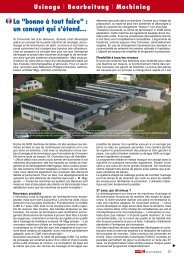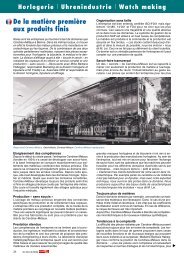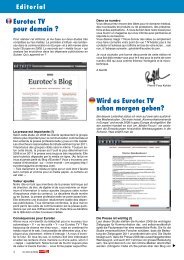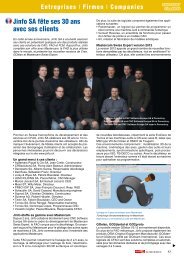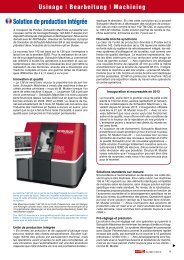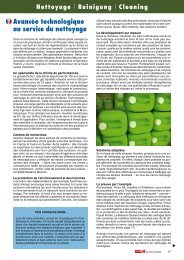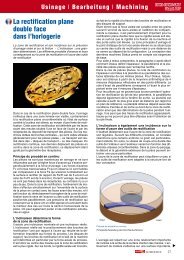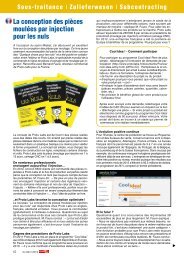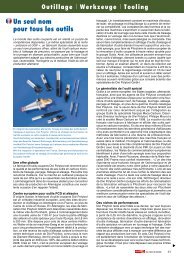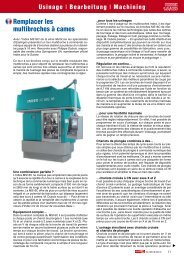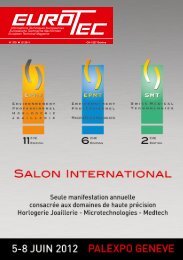EUROTEC N 382 (3/2012 )
EUROTEC N 382 (3/2012 )
EUROTEC N 382 (3/2012 )
You also want an ePaper? Increase the reach of your titles
YUMPU automatically turns print PDFs into web optimized ePapers that Google loves.
sich der reinigungsvorgang aufgrund der grossen Vielfalt sowie<br />
der zahlreichen geometrien und Zusammensetzungen<br />
(stahl, edelstahl, Messing, Zamak (Zinkdruckguss), Bronze,<br />
aluminium, Kupfer) äusserst komplex (Bilder 2 und 3)<br />
das mit dieser arbeit beauftragte Personal kann heute auf<br />
sehr leistungsstarke, sichere und umweltfreundlichere Maschinen<br />
zählen. Vor nicht allzu langer Zeit wurden solche teile mit<br />
trichloräthylen gereinigt – ein Produkt, das für seine schädlichkeit<br />
für Mensch und umwelt bekannt ist. das unternehmen<br />
tesa, das sich seit jeher für eine nachhaltige entwicklung<br />
eingesetzt hatte, beschloss vor einem Jahr, auf ein anderes<br />
reinigungssystem umzusteigen. nun ist endgültig schluss mit<br />
trichloräthylen, denn das unternehmen ersetzte es durch ein<br />
Produkt von ngl cleaning technology: rubifin nr. 4. „Dieses<br />
Produkt ist nicht nur ungiftig sondern darüber hinaus in der<br />
Lage, Öle wirksam zu trennen“, bestätigte Marcel Monnier.<br />
Permanentes Recycling<br />
hinter dem reinigungssystem der eingesetzten Maschine<br />
versteckt sich ein komplexes system: die anlage sorgt für<br />
ein ständiges recycling des reinigungsmittels, indem eine<br />
Destillation bei 140°C durchgeführt wird. Dieser Recyclingvorgang<br />
erfolgt mit hilfe von zwei Behältern (schmutzig/rein)<br />
mit einem gesamtfassungsvermögen von 400 liter. das Verfahren<br />
erfolgt unter Vakuumbedingungen, um eine grössere<br />
sicherheit aber auch eine höhere Wirksamkeit, insbesondere<br />
während des trockenvorgangs, zu gewährleisten.<br />
Je nachdem, was für teile gereinigt werden müssen, und abhängig<br />
vom Verschmutzungsgrad und der Beschichtung sind<br />
mehrere Waschprogramme verfügbar. Wenn grössere teile<br />
gereinigt werden sollen, greift tesa auf eine herkömmlichere<br />
spritzmaschine zurück (Bild 4).<br />
auch hier hat das unternehmen in renens auf die Produkte<br />
von ngl cleaning technologies vertraut, indem es ein reinigungsmittel<br />
der Produktlinie decosPraY wählte.<br />
die industriereinigungsprodukte<br />
und<br />
-verfahren von ngl<br />
sind das ergebnis<br />
von Forschungsarbeiten<br />
und erfahrungen,<br />
die in<br />
den bedeutendsten<br />
hochtechnologischenindustrieab-<br />
3<br />
teilungen gemacht<br />
wurden. dieses<br />
Know-how findet auch bei umweltanforderungen anwendung,<br />
die im rahmen der Beratung von industriellen bezüglich des<br />
umgangs mit abwasser auftreten. ngl cleaning technology<br />
entspricht den normen iso 9001 :2008 - iso und ohsas<br />
18001 und ist in der lage, eine grosse reihe umweltfreundlicher<br />
Produkte zu schaffen, herzustellen und zu vertreiben;<br />
diese Produkte werden den extrem hohen anforderungen<br />
von Bereichen wie Zahnimplantate, chirurgische Prothesen,<br />
uhrwerke und vieler anderer sektoren gerecht, in denen<br />
die reinigungsvorgänge bis vor Kurzem ausschliesslich mit<br />
lösungsmitteln ausgeführt wurden.<br />
Precision measuring -<br />
precision cleaning<br />
At TESA, precision parts cleaning is entrusted to NGL Cleaning<br />
Technology products. In its catalogue, this iconic company of<br />
Swiss precision has over 5000 instruments to which manufacturing<br />
and assembly require many efficient washes. Some<br />
companies instantly evoke the Swiss know-how. Tesa not only<br />
belongs to the Swiss economic landscape since 1941 but is<br />
nowadays a master in the field of precision measurement.<br />
80 No <strong>382</strong> (3/<strong>2012</strong>)<br />
the company is part of the hexagon Metrology swedish<br />
group. an important part of the production is realised on the<br />
site of renens, near lausanne (switzerland). the manufactured<br />
parts are subsequently assembled to fit as well in a few<br />
centimeters calipers (picture 1) as in probes that easily reach<br />
one meter and are able to measure in three dimensions. in<br />
between, we can find many various devices. the tesa catalogue<br />
contains more than 5000 dimensional metrology products.<br />
For the record and according to the saying “if you want<br />
something done, do it yourself”, much of these precision parts<br />
are realized on tesa machines…<br />
One million parts a year<br />
the excellence of these instruments is of course due to the<br />
extreme precision with which they are made. in this permanent<br />
race for quality, cleanliness is an essential pillar. But the<br />
task is daunting as Marcel Monnier, responsible for surface<br />
treatments at tesa, says:<br />
“We must wash between<br />
4<br />
600,000 and 1 million parts<br />
every year. They can be<br />
turned, abraded or polished<br />
before electroplated. Sometimes<br />
cleaning is necessary<br />
between all of these steps”.<br />
in addition, washing is made<br />
very complex because of the<br />
large variety of parts, their<br />
geometries but also materials<br />
(steel, stainless steel,<br />
brass, zamak, bronze, aluminum,<br />
copper) (pictures 2 and 3).<br />
nowadays those who are in charge of this work can count on<br />
highly efficient, safe and environmentally friendly machines.<br />
not so long ago, one cleaned such parts with trichloroethylene.<br />
We all know its toxicity both for men and for the environment.<br />
tesa has always been thinking on sustainable development<br />
and decided to change its washing system one year ago. exit<br />
trichloroethylene. the company replaced it with rubifin no. 4,<br />
a product provided by ngl cleaning technology. “Not only<br />
this product is not toxic, but it separates oils very well”, confirms<br />
Marcel Monnier.<br />
Permanent recycling<br />
the cleaning system of the used machine hides a complex<br />
system: the installation recycles the product continuously by<br />
distillation at 140°C. Two tanks, a dirty one and a clean one<br />
with a total capacity of 400 liters, allow this recycling. For<br />
security reasons, but also for efficiency, especially for drying,<br />
the process takes place in vacuum.<br />
several programs are available based on the parts to be<br />
washed, their degrees of dirt and their coatings. For large parts,<br />
tesa relies on a more traditional spray machine (picture 4).<br />
For this too the company of renens counts on ngl cleaning<br />
technology products of the decosPraY line.<br />
Products and methods of ngl are the results of researches<br />
and experiments performed in the main industrial divisions of<br />
high technologies. this expertise extends to the level of environmental<br />
protection and advice to industries for the choice<br />
of a mode of waste water management. complying with iso<br />
9001 - iso 14001 and ohsas 18001 standards, ngl cleaning<br />
technology formulates, manufactures and markets a wide<br />
range of ecological products that meets the requirements of<br />
extremely refined washing in areas such as dental implants,<br />
surgical prostheses, the delicate mechanisms of watchmaking<br />
and other sectors in which, until recent years, washing<br />
was carried out solely with solvent.<br />
NGL Cleaning Technology SA<br />
innovative cleaning solutions<br />
7, ch. de la Vuarpillière - ch-1260 nYon<br />
tél. 022 365 46 66 - Fax 022 361 81 03<br />
www.ngl-cleaning-technology.com<br />
ngl@ngl-cleaning-technology.com





